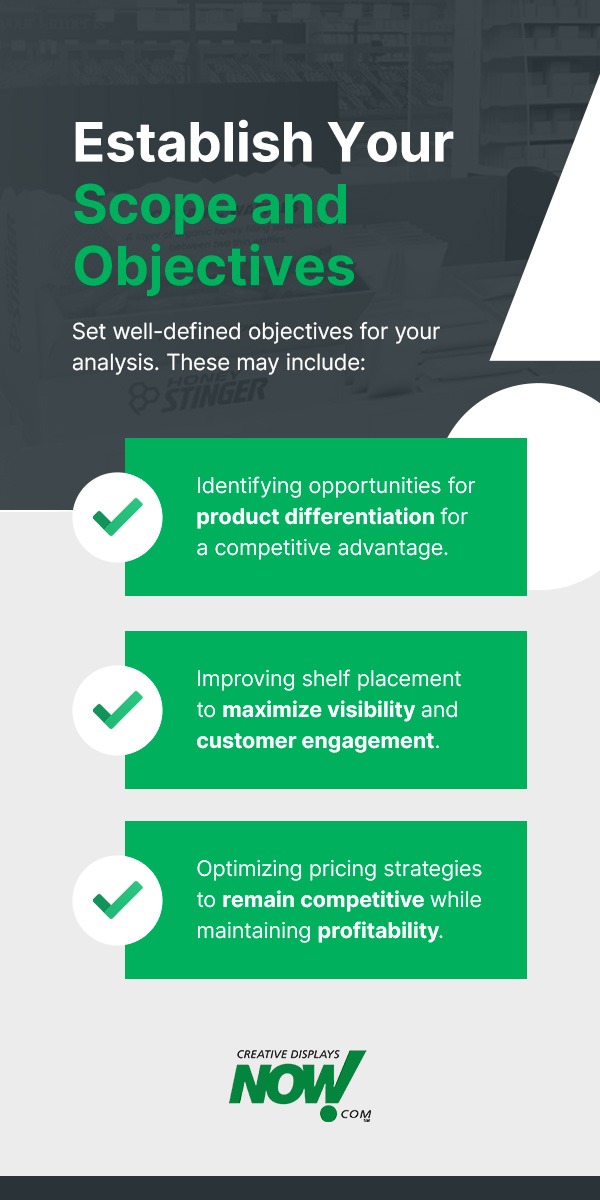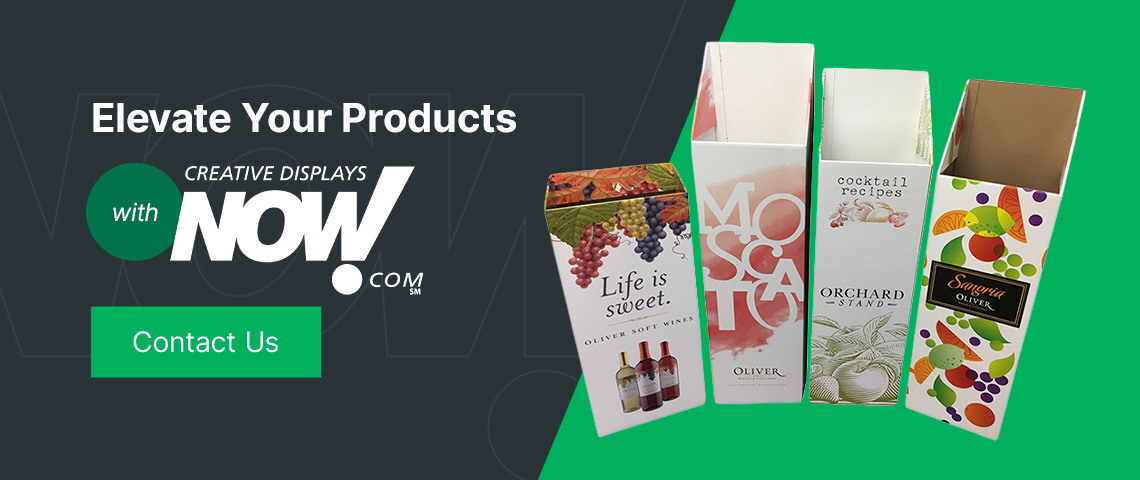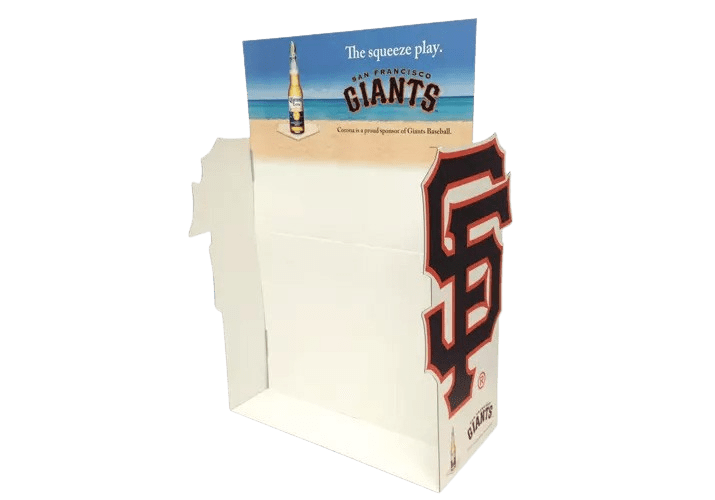Did you know that 95% of new products fail within the first year? In many cases, this failure can often be attributed to inadequate product analysis and suboptimal retail placement. Your products must capture customer attention and stand out on crowded store shelves to thrive in the challenging retail landscape.
Learn how to do competitor analysis to optimize your products for the retail environment. By following this process, you can create products that rise above the competition and drive sales.
What Is Product Competitive Analysis?
A product competitive analysis is a meticulous evaluation of your products compared to those of your competitors. This process involves a deep dive into various aspects of your product, including features, pricing, packaging, branding and retail placement.
Competitive product analysis aims to identify strengths, weaknesses, opportunities and threats. It provides invaluable insights for product development, marketing and retail strategies. A thorough competitor analysis can uncover key areas to gain a competitive advantage for your product and capture market share.
Why Is It Important in Retail?
The retail environment presents unique challenges and opportunities for product manufacturers. Due to limited shelf space and numerous products clamoring for customer attention, optimizing your product positioning and visual appeal for retail is critical. A well-executed competitive product analysis allows you to understand how your products measure up against competing items and pinpoint areas for improvement.
By closely examining factors like shelf placement, packaging design, pricing strategy, marketing and in-store displays, you can make data-driven decisions to enhance your products’ visibility and attractiveness to customers. This strategic approach ensures that your products stand out and align with customer preferences and expectations, ultimately driving sales and increasing brand loyalty.
Step-By-Step Guide to Conducting a Product Competitive Analysis
Conducting a competitor analysis can seem complex, but breaking it down into manageable steps can streamline the process and yield actionable insights.
1. Determine Who Your Competitors Are
The foundation of any successful competitive product analysis lies in accurately identifying your competitors. Direct competitors offer similar products to yours, and indirect competitors fulfill the same customer needs through alternative means.
To uncover your competitors, employ a multifaceted approach that includes:
- Conducting thorough online research, exploring industry websites, blogs and forums.
- Reviewing industry reports and market research to identify major players and emerging trends.
- Attending industry events to gather insights and observe competitor offerings.
- Performing retail audits to assess competitor presence and positioning in physical stores.
Once you have compiled a comprehensive list of competitors, create a competitor matrix to organize your findings. This visual representation will help you track and compare key aspects of each competitor’s products, making it easier to identify patterns and opportunities.
2. Establish Your Scope and Objectives
Before diving into the analysis itself, establish clear parameters and goals. Start by defining the specific aspects of your product you want to analyze, such as features, pricing, packaging or retail placement. This focused approach ensures that your analysis remains relevant and actionable.
Set well-defined objectives for your analysis. These may include:
- Identifying opportunities for product differentiation for a competitive advantage.
- Improving shelf placement to maximize visibility and customer engagement.
- Optimizing pricing strategies to remain competitive while maintaining profitability.
Articulating your scope and objectives upfront allows you to create a roadmap for your analysis, keeping you focused and aligned with your business goals.
3. Analyze Competitor Products
Evaluate your competitors’ product features and understand how they translate into customer benefits. Create a detailed breakdown of each competing product, listing all the features and specifications.
Analyze how these features provide value to customers by identifying the unique selling propositions (USPs) that set each competitor’s product apart. What makes their product stand out in the market? How does it compare to your offering?
With these findings, assess where your products excel and where there may be room for improvement. Are there gaps in the market that your product can fill? Are there features or benefits that your competitors are overlooking?
This detailed analysis will inform your product development efforts. By thoroughly understanding your competitors’ product features and benefits, you can position your product to meet and exceed customer expectations.
4. Examine Pricing Strategies
Pricing is a vital factor in the success of any product, and many companies struggle to find the right balance in this area. As part of your competitor research, closely examine your competitors’ pricing strategies:
- Are they positioning themselves as a premium, midrange or budget-friendly option?
- How do their prices compare to yours?
- Are they offering any promotions or discounts that could be impacting customer perception?
- Do their prices align with the perceived value they offer?
Identify areas where you can differentiate your product through pricing without compromising profitability, whether by offering a better value, premium features or unique pricing models.
5. Evaluate Packaging and Branding
Packaging and branding can be powerful tools for product differentiation marketing. Your competitive product analysis should thoroughly evaluate your competitors’ retail packaging design, materials and messaging.
Evaluate the visual impact of their retail packaging. Does it stand out on the shelf? Is it easy to read and understand? Does it effectively communicate the product’s benefits and the brand’s identity?
You should also assess how effectively your competitor’s packaging communicates their messaging. Is it clear, concise and compelling? Does it effectively communicate the product’s USPs and value proposition? Pinpoint strengths and weaknesses in their approach, considering how you can improve upon them in your packaging.
Your packaging and branding should create a cohesive and compelling story that resonates with your target audience. By studying your competitors’ packaging strategies, you can develop packaging that stands out on store shelves and reinforces your brand’s unique value proposition.
6. Assess Retail Placement and Displays
The way your product is presented in retail stores can influence customer perception and purchase decisions. Examine where your competitors’ products are placed and what types of displays they use.
Answer the following questions:
- Are their products at eye level or buried on the bottom shelf?
- What types of retail displays are they using (for example, endcaps, gondolas or custom displays)?
- Do their displays attract attention and drive sales?
- How are they using visual merchandising to enhance their products?
Note any innovative or eye-catching approaches they employ. Your analysis should consider the specific display guidelines and requirements of major retailers. Understanding their display specifications and preferences can help you develop retail displays that showcase your product, increase sales and meet the needs of your retail partners.
7. Scrutinize Marketing and Promotion
Your competitor research should extend beyond the product itself and into its marketing and promotion. Take a closer look at your competitors’ advertising campaigns, both online and offline, to understand their targeting strategies and messaging.
Visit their websites and social media profiles to assess the user experience and engagement levels. Note if they leverage influencer partnerships or other creative advertising strategies in their digital marketing efforts. You should also analyze their content marketing efforts, including blog posts, videos and other educational or entertaining content. Identify the essential themes and topics they focus on, evaluating the effectiveness of their approach.
By understanding your competitors’ marketing and promotional strategies, you can identify best practices and areas where you can differentiate your campaigns. This knowing will inform your product differentiation marketing plans, helping you develop targeted, impactful initiatives that resonate with your audience and drive product sales.
8. Survey Customer Reviews and Feedback
Direct customer feedback is one of the most valuable sources of information for your competitive product analysis. Gather and analyze reviews and ratings for your competitors’ products, paying close attention to positive and negative comments.
Identify common themes and patterns in customer feedback, such as:
- Frequently praised features or benefits.
- Common complaints or pain points.
- Suggestions for improvement.
Use social listening tools to monitor mentions of your competitors’ products across online forums and social media platforms. These mentions can provide a wealth of qualitative data on customer sentiment and preferences. Knowing what customers love or dislike about your competitors’ products allows you to find areas where your product can fill gaps or exceed expectations. This valuable feedback should guide your product development and customer service efforts, ensuring you continuously improve to meet the target market’s evolving needs.
9. Analyze the Data
With the vast data and insights collected from your competitive product analysis, it’s time to synthesize your findings to identify actionable opportunities. Conduct a SWOT analysis, evaluating your product’s strengths, weaknesses, opportunities and threats in relation to your competitors.
Identify your product’s competitive advantage areas, where it can outperform rivals. These may include unique features, superior quality or exceptional customer service. These are the strengths you will highlight in your marketing and sales efforts.
Simultaneously, conduct a gap analysis to uncover unmet customer needs or market gaps your product could address. Identifying market gaps may provide opportunities to develop new features, explore emerging retail trends or target underserved customer segments.
By systematically analyzing the data and identifying key opportunities, you can develop a strategic roadmap for your product’s success in the competitive retail landscape.
10. Identify Differentiation Strategies
With a deep understanding of your competitors and market opportunities, the next step is developing targeted product differentiation marketing strategies. Consider the following approaches:
- Feature differentiation: Highlight unique or superior features that set your product apart from competitors by focusing on benefits that align with customer needs and preferences.
- Price differentiation: Explore pricing strategies that provide a competitive advantage, such as offering better value, premium options or flexible pricing models.
- Branding differentiation: Strengthen your brand identity through compelling messaging, visuals and storytelling. Develop a unique brand voice that resonates with your target audience.
- Retail experience differentiation: Create engaging and memorable in-store experiences through innovative displays, interactive elements and personalized customer service.
Combining these differentiation strategies allows you to position your product as a standout choice in the competitive retail market.
11. Develop Actionable Product Improvement Plans
The final step in your competitive product analysis is translating your findings into concrete action plans. Use the insights gained and your competitive analysis examples for corporate advantage, perfecting essential areas of your business strategy, such as:
- Product development: Prioritize improvements to existing features or the addition of new ones based on customer needs and competitive gaps.
- Pricing: Optimize your pricing strategy to remain competitive while ensuring profitability. You could implement promotional offers or value-added bundles to entice customers.
- Marketing: Create targeted campaigns that highlight your product’s USPs and resonate with your target audience. Leverage the most effective channels and messaging based on competitor analysis.
- Retail strategy: Focus on securing optimal shelf placement and designing eye-catching corrugated cardboard displays that align with retail requirements and customer preferences. Implement visual merchandising techniques that enhance your product’s appeal.
Optimizing Retail Displays and Packaging for Maximum Impact
Effective displays capture customer attention and drive sales in crowded retail store environments. Retail displays communicate key product benefits and brand messaging, building brand recognition and loyalty. They also encourage impulse purchases and product trials, helping increase revenue.
While there are several materials to use for your retail displays, corrugated cardboard is the best option, offering the most cost-effective, flexible and sustainable displays. You can maximize the impact of your retail displays by leveraging display stands like endcaps, counter displays, floor stands and inline displays.
When designing your custom corrugated cardboard displays, follow these best practices:
- Visual appeal: Use eye-catching colors, graphics and lighting to draw attention to your products. Ensure that your displays stand out from competitors and align with your brand identity.
- Clear messaging: Communicate your product’s key benefits and USPs through concise and compelling copy. Use clear, legible fonts and strategic messaging hierarchies.
- Strategic placement: Collaborate with retailers to secure optimal display locations for maximum visibility and accessibility. Consider factors such as foot traffic patterns and proximity to complementary products.
- Durability and functionality: Invest in well-constructed displays that can withstand the rigors of the retail environment. Make sure your displays are easy to assemble, maintain, restock and take down for a professional and seamless experience.
In addition to displays, packaging is fundamental in retail. Your product packaging is often the first point of contact with potential customers and can influence their purchasing decisions. Use custom retail display packaging to protect the product during shipping and handling, and differentiate your products from others by:
- Attracting attention on crowded store shelves.
- Communicating key product information and benefits.
- Reinforcing brand identity and messaging.
- Encouraging impulse purchases.
By optimizing your retail displays and packaging, you can create a powerful in-store presence that differentiates your products, engages customers and drives sales.
Elevate Your Products With Creative Displays Now!
A comprehensive product competitive analysis is essential for success in the dynamic retail landscape. By following this 11-step guide, you can deeply understand your competitors, identify opportunities for product differentiation and design corrugated cardboard displays to help your products stand out on crowded store shelves.
To differentiate your products, partner with Creative Displays Now! With over 60 years of industry experience and a team of over 60 skilled structural designers, we create custom corrugated retail displays and packaging solutions that elevate your products. From concept development to seamless distribution, we offer a comprehensive range of services to ensure product differentiation in competitive retail environments.
Contact us today to elevate your products and rise above the competition.







